文艺复兴 英文简介
- 格式:ppt
- 大小:7.53 MB
- 文档页数:85
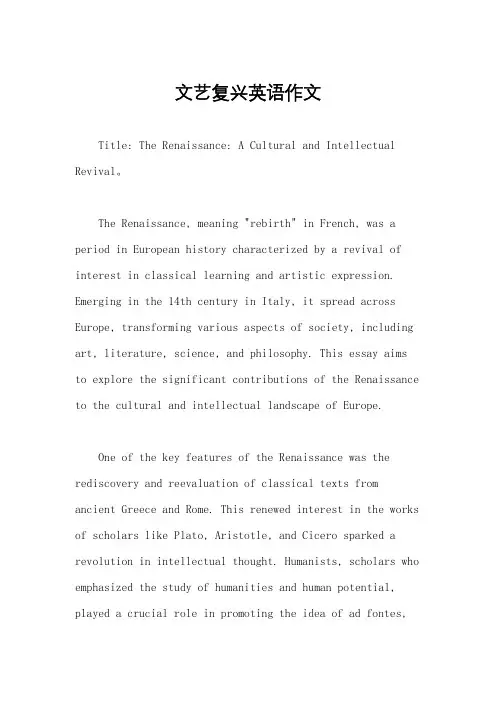
文艺复兴英语作文Title: The Renaissance: A Cultural and Intellectual Revival。
The Renaissance, meaning "rebirth" in French, was a period in European history characterized by a revival of interest in classical learning and artistic expression. Emerging in the 14th century in Italy, it spread across Europe, transforming various aspects of society, including art, literature, science, and philosophy. This essay aims to explore the significant contributions of the Renaissance to the cultural and intellectual landscape of Europe.One of the key features of the Renaissance was the rediscovery and reevaluation of classical texts from ancient Greece and Rome. This renewed interest in the works of scholars like Plato, Aristotle, and Cicero sparked a revolution in intellectual thought. Humanists, scholars who emphasized the study of humanities and human potential, played a crucial role in promoting the idea of ad fontes,or "to the sources," encouraging individuals to seek knowledge directly from original texts rather than relying on interpretations.Art during the Renaissance underwent a profound transformation. The period saw the emergence of great masters such as Leonardo da Vinci, Michelangelo, and Raphael, whose works exemplified the principles of balance, harmony, and realism. The invention of perspective allowed artists to create more lifelike representations of the world, while innovations in techniques such as chiaroscuro and sfumato added depth and dimension to their paintings. Art became a means of expressing human emotions, ideals, and the beauty of the natural world.Literature flourished during the Renaissance, with writers producing works that celebrated the human experience and explored complex themes of love, politics, and morality. Italian poets like Petrarch and Dante Alighieri pioneered the use of vernacular languages, elevating them to the status of literary expression previously reserved for Latin. The printing press, inventedby Johannes Gutenberg in the mid-15th century, facilitated the mass production of books, leading to increased literacy rates and the widespread dissemination of knowledge.The Renaissance also witnessed significant advancements in science and technology. Scholars like Nicolaus Copernicus challenged the geocentric model of the universe, proposing a heliocentric model where the Earth revolved around the sun. This astronomical revolution laid the groundwork for further scientific inquiry and eventually led to the development of modern astronomy. Meanwhile, artists and inventors like Leonardo da Vinci explored various fields of study, contributing to advancements in anatomy, engineering, and architecture.The spirit of inquiry and exploration that characterized the Renaissance extended beyond intellectual pursuits to encompass geographical exploration and trade. Explorers like Christopher Columbus, Vasco da Gama, and Ferdinand Magellan embarked on voyages of discovery, expanding European knowledge of the world and establishing new trade routes. The influx of goods, ideas, and culturesfrom distant lands enriched European society and stimulated further innovation and exchange.In conclusion, the Renaissance was a transformative period in European history that witnessed a revival of classical learning, artistic creativity, and scientific inquiry. Its impact reverberated across various spheres of society, shaping the course of Western civilization and laying the groundwork for the modern world. Through its emphasis on humanism, innovation, and exploration, the Renaissance remains a testament to the enduring power of human creativity and ingenuity.。
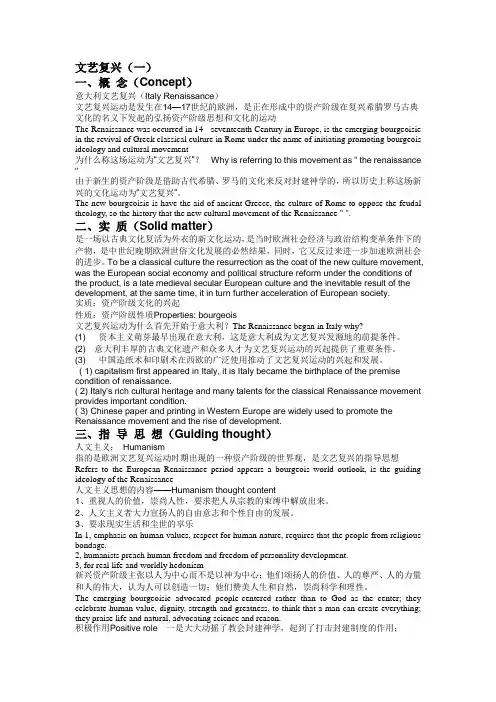
文艺复兴(一)一、概念(Concept)意大利文艺复兴(Italy Renaissance)文艺复兴运动是发生在14—17世纪的欧洲,是正在形成中的资产阶级在复兴希腊罗马古典文化的名义下发起的弘扬资产阶级思想和文化的运动The Renaissance was occurred in 14 - seventeenth Century in Europe, is the emerging bourgeoisie in the revival of Greek classical culture in Rome under the name of initiating promoting bourgeois ideology and cultural movement为什么称这场运动为“文艺复兴”?Why is referring to this movement as " the renaissance "由于新生的资产阶级是借助古代希腊、罗马的文化来反对封建神学的,所以历史上称这场新兴的文化运动为“文艺复兴”。
The new bourgeoisie is have the aid of ancient Greece, the culture of Rome to oppose the feudal theology, so the history that the new cultural movement of the Renaissance " ".二、实质(Solid matter)是一场以古典文化复活为外衣的新文化运动,是当时欧洲社会经济与政治结构变革条件下的产物,是中世纪晚期欧洲世俗文化发展的必然结果,同时,它又反过来进一步加速欧洲社会的进步。
To be a classical culture the resurrection as the coat of the new culture movement, was the European social economy and political structure reform under the conditions of the product, is a late medieval secular European culture and the inevitable result of the development, at the same time, it in turn further acceleration of European society.实质:资产阶级文化的兴起性质:资产阶级性质Properties: bourgeois文艺复兴运动为什么首先开始于意大利?The Renaissance began in Italy why?(1) 资本主义萌芽最早出现在意大利,这是意大利成为文艺复兴发源地的前提条件。
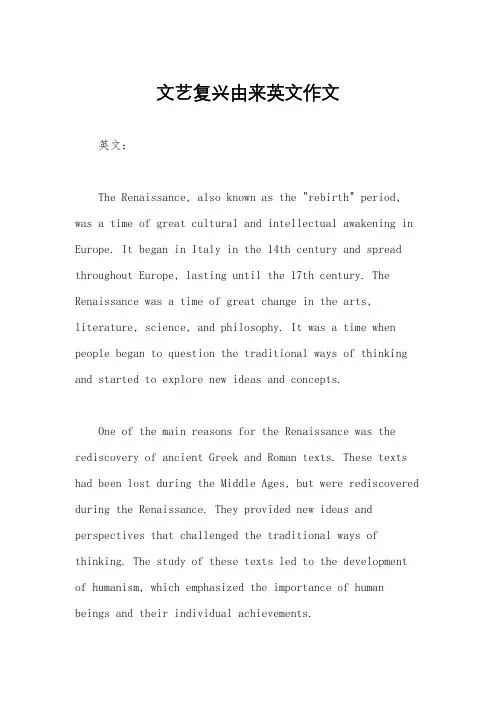
文艺复兴由来英文作文英文:The Renaissance, also known as the "rebirth" period, was a time of great cultural and intellectual awakening in Europe. It began in Italy in the 14th century and spread throughout Europe, lasting until the 17th century. The Renaissance was a time of great change in the arts, literature, science, and philosophy. It was a time when people began to question the traditional ways of thinking and started to explore new ideas and concepts.One of the main reasons for the Renaissance was the rediscovery of ancient Greek and Roman texts. These texts had been lost during the Middle Ages, but were rediscovered during the Renaissance. They provided new ideas and perspectives that challenged the traditional ways of thinking. The study of these texts led to the development of humanism, which emphasized the importance of human beings and their individual achievements.Another reason for the Renaissance was the growth of trade and commerce. As Europe became more connected through trade, ideas and knowledge were able to spread more easily. This led to the exchange of ideas between differentcultures and the development of new technologies.In addition, the Renaissance was also fueled by the patronage of wealthy individuals and families. These patrons provided financial support to artists, writers, and scholars, which allowed them to pursue their work and create new ideas.Overall, the Renaissance was a time of great change and innovation. It was a time when people began to think for themselves and explore new ideas. This period had a profound impact on the development of modern Western society.中文:文艺复兴,也称为“复兴”时期,是欧洲文化和知识的伟大复苏时期。
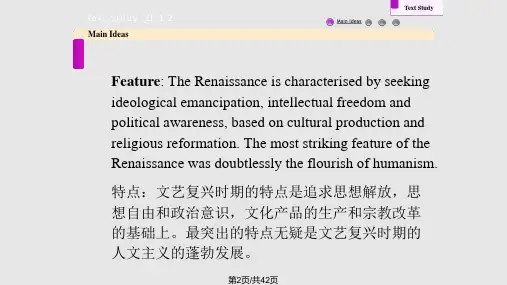
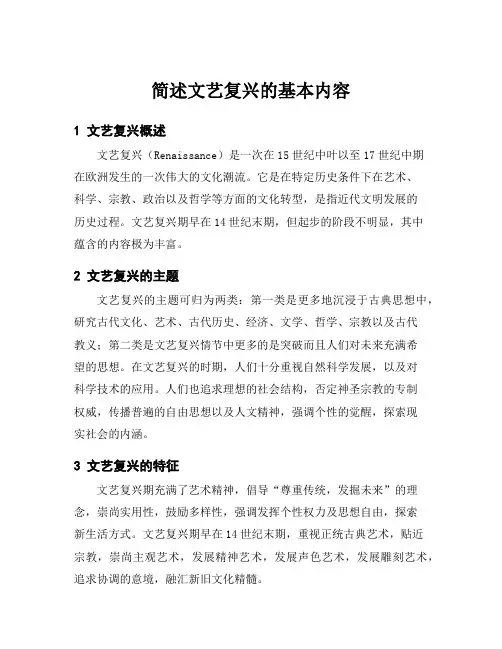
简述文艺复兴的基本内容
1 文艺复兴概述
文艺复兴(Renaissance)是一次在15世纪中叶以至17世纪中期
在欧洲发生的一次伟大的文化潮流。
它是在特定历史条件下在艺术、
科学、宗教、政治以及哲学等方面的文化转型,是指近代文明发展的
历史过程。
文艺复兴期早在14世纪末期,但起步的阶段不明显,其中
蕴含的内容极为丰富。
2 文艺复兴的主题
文艺复兴的主题可归为两类:第一类是更多地沉浸于古典思想中,研究古代文化、艺术、古代历史、经济、文学、哲学、宗教以及古代
教义;第二类是文艺复兴情节中更多的是突破而且人们对未来充满希
望的思想。
在文艺复兴的时期,人们十分重视自然科学发展,以及对
科学技术的应用。
人们也追求理想的社会结构,否定神圣宗教的专制
权威,传播普遍的自由思想以及人文精神,强调个性的觉醒,探索现
实社会的内涵。
3 文艺复兴的特征
文艺复兴期充满了艺术精神,倡导“尊重传统,发掘未来”的理念,崇尚实用性,鼓励多样性,强调发挥个性权力及思想自由,探索
新生活方式。
文艺复兴期早在14世纪末期,重视正统古典艺术,贴近
宗教,崇尚主观艺术,发展精神艺术,发展声色艺术,发展雕刻艺术,追求协调的意境,融汇新旧文化精髓。
4 文艺复兴的意义
文艺复兴期间发生的文化材料及艺术表现,它们不只是单纯的艺术形式,更多的是表达了现代艺术的思想意义以及文化价值。
文艺复兴的精神极大地激励了人类的精神追求,令社会迈向新的文化路径。
文艺复兴也使欧洲文化走向繁荣,科学和社会有了大革新,最重要的是人们发展了一个向外看的视野,特别是全球思维的实践,也为人类走向现代文明路径铺了基础。
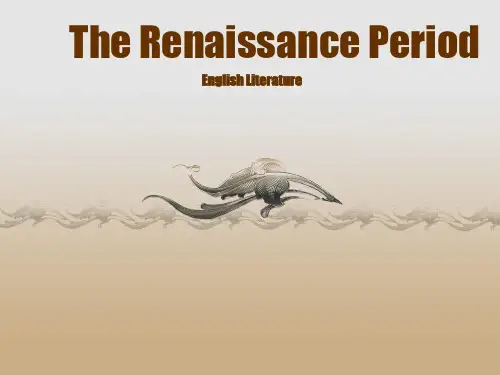
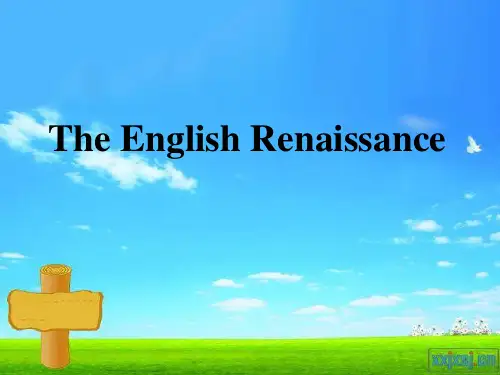
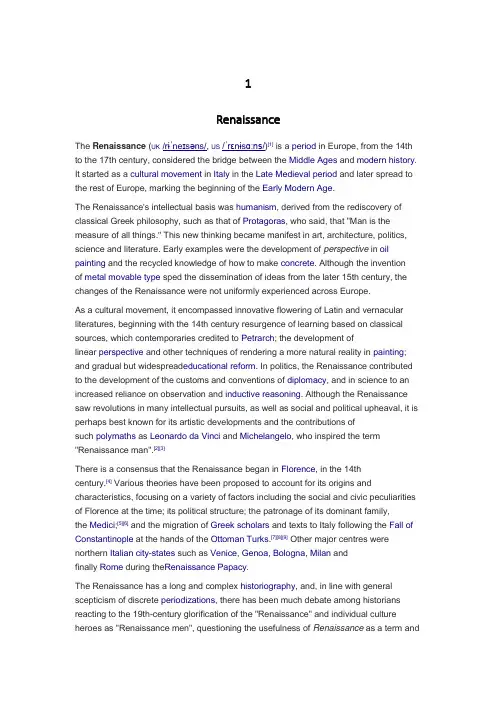
1RenaissanceThe Renaissance (UK/rɨˈneɪsəns/, US/ˈrɛnɨsɑːns/)[1] is a period in Europe, from the 14th to the 17th century, considered the bridge between the Middle Ages and modern history. It started as a cultural movement in Italy in the Late Medieval period and later spread to the rest of Europe, marking the beginning of the Early Modern Age.The Renaissance's intellectual basis was humanism, derived from the rediscovery of classical Greek philosophy, such as that of Protagoras, who said, that "Man is the measure of all things." This new thinking became manifest in art, architecture, politics, science and literature. Early examples were the development of perspective in oil painting and the recycled knowledge of how to make concrete. Although the inventionof metal movable type sped the dissemination of ideas from the later 15th century, the changes of the Renaissance were not uniformly experienced across Europe.As a cultural movement, it encompassed innovative flowering of Latin and vernacular literatures, beginning with the 14th century resurgence of learning based on classical sources, which contemporaries credited to Petrarch; the development oflinear perspective and other techniques of rendering a more natural reality in painting; and gradual but widespread educational reform. In politics, the Renaissance contributed to the development of the customs and conventions of diplomacy, and in science to an increased reliance on observation and inductive reasoning. Although the Renaissance saw revolutions in many intellectual pursuits, as well as social and political upheaval, it is perhaps best known for its artistic developments and the contributions ofsuch polymaths as Leonardo da Vinci and Michelangelo, who inspired the term "Renaissance man".[2][3]There is a consensus that the Renaissance began in Florence, in the 14thcentury.[4] Various theories have been proposed to account for its origins and characteristics, focusing on a variety of factors including the social and civic peculiarities of Florence at the time; its political structure; the patronage of its dominant family,the Medici;[5][6] and the migration of Greek scholars and texts to Italy following the Fall of Constantinople at the hands of the Ottoman Turks.[7][8][9] Other major centres were northern Italian city-states such as Venice, Genoa, Bologna, Milan andfinally Rome during the Renaissance Papacy.The Renaissance has a long and complex historiography, and, in line with general scepticism of discrete periodizations, there has been much debate among historians reacting to the 19th-century glorification of the "Renaissance" and individual culture heroes as "Renaissance men", questioning the usefulness of Renaissance as a term andas a historical delineation.[10] The art historian Erwin Panofsky observed of this resistance to the concept of "Renaissance":It is perhaps no accident that the factuality of the Italian Renaissance has been most vigorously questioned by those who are not obliged to take a professional interest in the aesthetic aspects of civilization—historians of economic and social developments, political and religious situations, and, most particularly, natural science—but only exceptionally by students of literature and hardly ever by historians of Art.[11]Some observers have called into question whether the Renaissance was a cultural "advance" from the Middle Ages, instead seeing it as a period of pessimismand nostalgia for classical antiquity,[12] while social and economic historians, especially of the longue durée, have instead focused on the continuity between the two eras[13] which are linked, as Panofsky himself observed, "by a thousand ties".[14]The word Renaissance, literally meaning "Rebirth" in French, first appears in English in the 1830s.[15] The word occurs in Jules Michelet's 1855 work, Histoire de France. The word Renaissance has also been extended to other historical and cultural movements, such as the Carolingian Renaissance and the Renaissance of the 12th century.[16]2RepresentativesAlfred Tennyson, among many others. In addition, the first use of the interlockingthree-line rhyme scheme, or the terza rima, is attributed to him.Dante has been called "the Father of the Italian language".[2] In Italy, Dante is often referred to as il Sommo Poeta("the Supreme Poet") and il Poeta; he, Petrarch, and Boccaccio are also called "the three fountains" or "the three crowns".The Divine Comedy describes Dante's journeythrough Hell (Inferno), Purgatory (Purgatorio), and Paradise (Paradiso)Dante, like most Florentines of his day, was embroiled in the Guelph–Ghibelline conflict. He fought in the Battle of Campaldino (June 11, 1289), with the Florentine Guelphs against Arezzo Ghibellines; then in 1294 he was among the escorts of Charles Martel of Anjou (grandson of Charles I of Naples, more commonly called Charles of Anjou) while he was in Florence. To further his political career, he became a pharmacist. He did not intend to practice as one, but a law issued in 1295 required nobles aspiring to public office to be enrolled in one of the CorporazionidelleArti e deiMestieri, so Dante obtained admission to the Apothecaries' Guild. This profession was not inappropriate, since at that time books were sold from apothecaries' shops. As a politician he accomplished little, but held various offices over some years in a city rife with political unrest.After defeating the Ghibellines, the Guelphs divided into two factions: the White Guelphs (Guelfi Bianchi)—Dante's party, led by VierideiCerchi—and the Black Guelphs (GuelfiNeri), led by Corso Donati. Although the split was along family lines at first, ideological differences arose based on opposing views of the papal role in Florentine affairs, with the Blacks supporting the Pope and the Whites wanting more freedom from Rome. The Whites took power first and expelled the Blacks. In response, Pope Boniface VIII planned a military occupation of Florence. In 1301, Charles of Valois, brother ofKing Philip IV of France, was expected to visit Florence because the Pope had appointed him peacemaker for Tuscany. But the city's government had treated the Pope's ambassadors badly a few weeks before, seeking independence from papal influence. It was believed that Charles had received other unofficial instructions, so the council sent a delegation to Rome to ascertain the Pope's intentions. Dante was one of the delegates.2. Leonardo da Vinci。
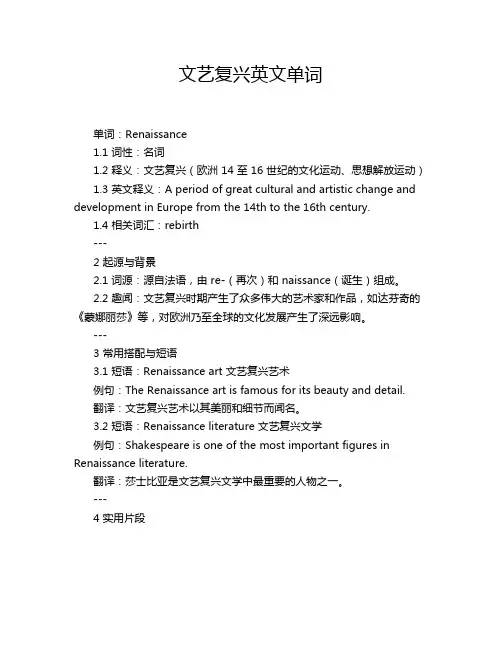
文艺复兴英文单词单词:Renaissance1.1 词性:名词1.2 释义:文艺复兴(欧洲 14 至 16 世纪的文化运动、思想解放运动)1.3 英文释义:A period of great cultural and artistic change and development in Europe from the 14th to the 16th century.1.4 相关词汇:rebirth---2 起源与背景2.1 词源:源自法语,由 re-(再次)和 naissance(诞生)组成。
2.2 趣闻:文艺复兴时期产生了众多伟大的艺术家和作品,如达芬奇的《蒙娜丽莎》等,对欧洲乃至全球的文化发展产生了深远影响。
---3 常用搭配与短语3.1 短语:Renaissance art 文艺复兴艺术例句:The Renaissance art is famous for its beauty and detail.翻译:文艺复兴艺术以其美丽和细节而闻名。
3.2 短语:Renaissance literature 文艺复兴文学例句:Shakespeare is one of the most important figures in Renaissance literature.翻译:莎士比亚是文艺复兴文学中最重要的人物之一。
---4 实用片段(1) "I'm studying the Renaissance period in history class. It's so fascinating to learn about the great thinkers and artists of that time." said Tom. "Yes, the Renaissance was a time of great innovation and creativity." replied the teacher.翻译:“我在历史课上学习文艺复兴时期。
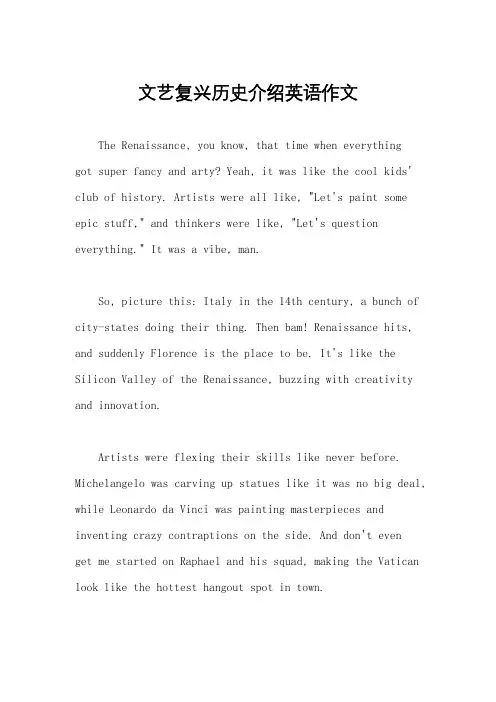
文艺复兴历史介绍英语作文The Renaissance, you know, that time when everythinggot super fancy and arty? Yeah, it was like the cool kids' club of history. Artists were all like, "Let's paint some epic stuff," and thinkers were like, "Let's question everything." It was a vibe, man.So, picture this: Italy in the 14th century, a bunch of city-states doing their thing. Then bam! Renaissance hits, and suddenly Florence is the place to be. It's like the Silicon Valley of the Renaissance, buzzing with creativity and innovation.Artists were flexing their skills like never before. Michelangelo was carving up statues like it was no big deal, while Leonardo da Vinci was painting masterpieces and inventing crazy contraptions on the side. And don't evenget me started on Raphael and his squad, making the Vatican look like the hottest hangout spot in town.But it wasn't just about art; the Renaissance was a whole vibe of intellectual awakening. Scholars were dusting off ancient manuscripts, rediscovering Plato and Aristotle, and sparking debates that would make your head spin. Humanism was all the rage, celebrating the power of the individual and the beauty of human potential.Oh, and let's not forget about the printing press. Gutenberg was out here revolutionizing the game, spreading ideas faster than you could say "Gutten-who?"But like any good party, the Renaissance had its dark side too. The Church was flexing its muscles, throwing shade at anything that didn't fit its narrative. Galileo found himself in hot water for suggesting that maybe, just maybe, the Earth wasn't the center of the universe.And then there were the politics. Italy was basically a hot mess of power struggles and backstabbing, with rival families duking it out for control. Machiavelli wrote the ultimate guidebook for aspiring rulers, basically saying, "It's not personal, it's just politics."But despite the drama, the Renaissance was a vibe, a cultural explosion that changed the world forever. It was like the ultimate mixtape of art, science, and philosophy, setting the stage for the modern world we know today. So yeah, next time you're admiring a Renaissance painting or pondering the mysteries of the universe, just remember: it all started with a bunch of cool kids in Italy, living their best Renaissance life.。
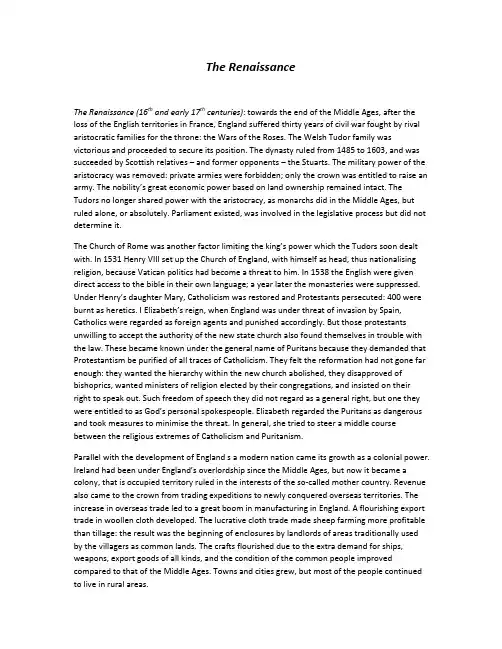
The RenaissanceThe Renaissance (16th and early 17th centuries): towards the end of the Middle Ages, after the loss of the English territories in France, England suffered thirty years of civil war fought by rival aristocratic families for the throne: the Wars of the Roses. The Welsh Tudor family was victorious and proceeded to secure its position. The dynasty ruled from 1485 to 1603, and was succeeded by Scottish relatives – and former opponents – the Stuarts. The military power of the aristocracy was removed: private armies were forbidden; only the crown was entitled to raise an army. The nobility’s great economic power based on land ownership remained intact. The Tudors no longer shared power with the aristocracy, as monarchs did in the Middle Ages, but ruled alone, or absolutely. Parliament existed, was involved in the legislative process but did not determine it.The Church of Rome was another factor limiting the king’s power which the Tudors soon dealt with. In 1531 Henry VIII set up the Church of England, with himself as head, thus nationalising religion, because Vatican politics had become a threat to him. In 1538 the English were given direct access to the bible in their own language; a year later the monasteries were suppressed. Under Henry’s daughte r Mary, Catholicism was restored and Protestants persecuted: 400 were burnt as heretics. I Elizabeth’s reign, when England was under threat of invasion by Spain, Catholics were regarded as foreign agents and punished accordingly. But those protestants unwilling to accept the authority of the new state church also found themselves in trouble with the law. These became known under the general name of Puritans because they demanded that Protestantism be purified of all traces of Catholicism. They felt the reformation had not gone far enough: they wanted the hierarchy within the new church abolished, they disapproved of bishoprics, wanted ministers of religion elected by their congregations, and insisted on their right to speak out. Such freedom of speech they did not regard as a general right, but one they were entitled to as God’s personal spokespeople. Elizabeth regarded the Puritans as dangerous and took measures to minimise the threat. In general, she tried to steer a middle course between the religious extremes of Catholicism and Puritanism.Parallel with the development of England s a modern nation came its growth as a colonial power. Ireland had been under England’s overlordship since the Middle Ages, but now it became a colony, that is occupied territory ruled in the interests of the so-called mother country. Revenue also came to the crown from trading expeditions to newly conquered overseas territories. The increase in overseas trade led to a great boom in manufacturing in England. A flourishing export trade in woollen cloth developed. The lucrative cloth trade made sheep farming more profitable than tillage: the result was the beginning of enclosures by landlords of areas traditionally used by the villagers as common lands. The crafts flourished due to the extra demand for ships, weapons, export goods of all kinds, and the condition of the common people improved compared to that of the Middle Ages. Towns and cities grew, but most of the people continued to live in rural areas.During the 16th and early 17th centuries, therefore, the people of England transformed the basis of their national and spiritual life. They also broadened their intellectual horizons and fashioned from a newly augmented language one of the great literatures of the western world. The period is known as the Renaissance; the term Renaissance (‘rebirth’) originally indicated a revival of classical (Greek and Roman) arts and sciences after the dark ages of medieval obscurantism. Renaissance writers returned to the classical sources of ‘humane letter’ in an attempt to find new ways of generating ideas and promoting a written and spoken eloquence greater in purity than the crabbed Latin of Medieval schoolmen.In line with the period’s enthusiasm for classical literature and art is a renewed b elief in humanism (a belief in human-based morality rather than in any supernatural authority). They believed, as Alexander Pope was to phrase it much later, that ‘the proper study of mankind is man’, rather than scholastic theology. For humanists the divi ne principle of reason was the guideline and that they found better realised in the classical world of antiquity than in the Middle Ages. They hoped to create a new civilisation in Europe at least equalling that of the old world. Thomas More wrote Utopia (1516) in which he puts forward his ideal of a future happy society. More’s book owes a considerable debt to Plato’s Republic and the Greek satirist Lucian. More’s topics include the corruption of the rich, the sufferings of the poor and the injustice of the death penalty for starving thieves. For More, only Utopia, where private property has been abolished, offers hope of an ideal state. The irony lies in the fact that utopia means ‘nowhere’. Utopia, however, provided a blueprint for a high-minded, money-free collective where a rational code is valued.Humanist ideals led to a widespread concern with education and many schools were formed, especially for boys who were educated in the faith of Christ and in classical literature (girls were for centuries deprived of a formal education). The study of Christian and pagan authors was seen as the best way to prepare men for the vicissitudes of life. Thus classical authors were studied as guides to life. An important aspect of the rhetorical training of the humanist schools in the Renaissance was the absorption of large numbers of received conventions or commonplaces of description (such as traditional similes) called topoi. All Renaissance students were taught, as part of their basic training, to amplify, vary, and enrich these topoi or received ideas in novel or copious ways. Shakespeare’s Sonnet 73 (1609) can be seen as a virtuoso example of this Renaissance rhetorical training in which the poem’s speaker attempts to persuade the addressee to regard him in a certain way. Each of the quatrains contains a different, extended metaphor for the speaker’s age or condition: (i) as late autumn, (ii) as twilight, (iii) as a dying fire. All three metaphors are commonplace ways, or received topoi, of representing old age, yet the interesting thing about the poem is that it revitalises these ‘old’ or ‘tired’ metaphors by extending them, and making them precise and specific rather than vaguely general.A further shaping influence on the literature of the period were the religious movements of the Reformation. The authority of the Catholic Church was no longer seen as infallible; indeed, ordinary individuals believed that they did not need the help of a priest to interpret scripture.Luther did not believe that the Catholic Church could save souls but that a man’s salvation depended on God’s grace and justification by faith alone. Private experience became the means of the deepest spiritual discovery. Reading scripture became more important than listening to a priest. There was a move here towards individualism.Both Protestantism and humanism had a formative influence on the genius of William Shakespeare. In common with other Elizabethan dramatists, his dramas broke away from the religious domination evident in the crypto-Catholic mystery and morality plays of the medieval era, and show an interest in the classics that is matched by a vivid social realism. Of all his dramas, the tragedies are generally regarded as Shakespeare’s supreme achievement. As in Greek tragedy, many of the main figures are kings and queens (e. g. Claudius and Gertrude in Hamlet); ordinary individuals are not yet considered appropriate vehicles for edification. However, we do not remember Hamlet because he is the king’s son but, rather, because of his personality. During the Tudor age the fate of a nation depended to a greater extent than in medieval times on the character of the rulers; it is therefore not surprising that drama produced the greatest literary individuals the stage had ever seen. The tragic fate of these individuals is not caused by external forces outside their control but is of their own making: their downfall is caused by specific features of character or weaknesses exposed under exceptional circumstances. Consider Hamlet’s inability to make up his mind, for example; a tragic flaw that led to his own death and the death of many innocent people. The tumultuous nature of his time had made Shakespeare acutely aware of the precariousness of fortune and character, and how quickly the veneer of civilisation could disintegrate under adverse conditions.Sonnet no. 73 (William Shakespeare)That time of year thou mayest in me beholdWhen yellow leaves, or none, or few, do hangUpon those boughs which shake against the cold,bare ruin'd choirs, where late the sweet birds sang.In me thou see'st the twilight of such dayAs after sunset fadeth in the west,Which by and by black night doth take away,Death's second self, that seals up all in rest.In me thou see'st the glowing of such fire,That on the ashes of his youth doth lie,As the death-bed whereon it must expireConsum'd with that which it was nourish'd by. This thou perceiv'st, which makes thy love more strong, To love that well which thou must leave ere long.(i)Identify the conceit and ‘Volta’ in Sonnet 73.。
解释文艺复兴的英语作文The Renaissance, which means "rebirth" in French, was a period of great cultural and intellectual awakening that took place in Europe from the 14th to the 17th century. During this time, there was a renewed interest in the classical texts of Greece and Rome, as well as a focus on humanism and individualism. The Renaissance was a time of great change and progress, and it had a profound impact on the arts, literature, science, and politics of the time.The Renaissance began in Italy in the 14th century and spread throughout Europe over the next few hundred years. One of the key factors that contributed to the rise of the Renaissance was the rediscovery of classical texts. During the Middle Ages, many of these texts had been lost or forgotten, but they were rediscovered during the Renaissance and became the basis for much of theintellectual and artistic activity of the time.Another important factor in the Renaissance was therise of humanism, which emphasized the importance of individualism and the potential of human beings to achieve great things. This philosophy was reflected in the art and literature of the time, which often depicted human figures in realistic and naturalistic ways, rather than thestylized and symbolic representations of the Middle Ages.The Renaissance was also a time of great innovation and progress in science and technology. Scientists and inventors made significant advances in fields such as astronomy, physics, and medicine, and new technologies such as the printing press and the compass were invented, which had a profound impact on the world.In addition to its intellectual and artistic achievements, the Renaissance also had a significant impact on politics and society. The rise of humanism and individualism led to a greater emphasis on democracy and the rights of the individual, and many of the political and social structures of the time were reformed or replaced as a result.In conclusion, the Renaissance was a period of great change and progress that had a profound impact on the world. Its focus on classical texts, humanism, and individualism, as well as its innovations in science and technology, continue to influence our culture and society today.。
The RenaissanceT he Renaissance refers to the period in European civilization towards the end of the Middle Ages, which was characterized by a surge of interest in classical learning and values.1.The origin of the RenaissanceThe Renaissance emerged when social instability, economic sluggishness and intellectual depression became so intolerable that most of the people, especially the intellectuals could no longer accept the worsening situation. The Renaissance as a movement first started in Florence and then expanded to Venice, Rome and other Italian cities before it swept the rest parts of Europe. Painting and sculpture were the most sensitive fields to the change with their subjects and tastes, shifting from dullness, stagnation, lack of emotion and divinity to dynamics, enthusiasm and humanitarianism. Literature and ideology soon followed as other important areas proceeded and the movement further separated itself from feudalistic tyranny, ecclesiastic bondage and sought intellectual freedom and ideological emancipation.2.The characteristics of the RenaissanceThe Renaissance is characterized by seeking ideological emancipation, intellectual freedom and political awareness, based on cultural production and religious reformation. All these were undertaken or unfolded gradually but widely, extending its influences to every corner of Europe, with more and more people getting involved. The achievements were seen principally in six areas, namely, painting, sculpture, poetry, fiction, drama and religious reformation as well as the change in the cultural and intellectual climate.3.The influence of the RenaissanceThe Renaissance was an important stage in the historical process of the Western civilization and indicated a transitional period from the Middle Ages to the modern era in the development of Western culture. Economic and intellectual changes during the Renaissance both helped to speed up Western social and cultural development and prepared the necessary conditions for the rapid progress in political, social and ideological areas of the Modern Age.文艺复兴是指由于意大利最早产生了资本主义萌芽,13世纪末在意大利兴起,以后扩散到西欧各国,16世纪盛行的一场思想文化运动。
Harlem RenaissanceHarlem Renaissance (HR) is the name given to the period from the end of World War I and through the middle of the 1930s Depression, during which a group of talented African-American writers produced a sizable body of literature in the four prominent genres of poetry, fiction, drama, and essay.Hero / Celebrity(1902—1967)HARLEM RENAISSANCEAfter the American civil war, liberated African-Americans searched for a safe place to explore their new identities as free men and women. They found it in Harlem. Read on to find out how this New York neighborhood became home to some of the best and brightest minds of the 20th century, gave birth to a cultural revolution, and earned its status as "the capital of black America." THE GREAT MIGRATIONThe end of the American Civil War in 1865 ushered in an era of increased education and employment opportunities for black Americans. This created the first black middle class in America, and its members began expecting the same lifestyle afforded to white Americans. But in 1896, racial equality was delivered a crushing blow when the Plessy v. Ferguson Supreme Court case declared racial segregation to be constitutionally acceptable. This created even harsher conditions for African-Americans, particularly in some Southern states that sought to minimize the equality that former slaves and their descendants might aspire toward. The South also became gradually more and more economically depressed as boll weevils began to infest cotton crops. This reduced the amount of labor needed in the South.As a result, blacks began to head to the Northern United States by the millions. Racism, while still a serious obstacle, was considered much less brutal there than in the South. In addition, the North granted all adult men with the right to vote; provided better educational advancement for African-Americans and their children; and offered greater job opportunities as a result of World War I and the industrial revolution. This phenomenon, known as the Great Migration, brought more than seven million African-Americans to the North.HARLEM: THE BLACK MECCAHousing executives planned to create neighborhoods in Harlem designed specifically for white workers who wanted to commute into the city. Developers grew overambitious, however, and housing grew more rapidly than the transportation necessary to bring residents into the downtown area. The once exclusive district was abandoned by the white middle-class, and frustrated developers were forced to cope with lower purchase prices than they first anticipated. White Harlem landlords started selling their properties to black real estate agents such as Philip A. Payton, John E. Nail, and Henry C. Parker. They also began renting directly to black tenants.Meanwhile, the re-development and gentrification of midtown pushed many blacks out of the Metropolitan area. As a result, African-Americans began moving to Harlem en masse; between 1900 and 1920 the number of blacks in the New York City neighborhood doubled. By the time the planned subway system and roadways reached Harlem, many of the country's best and brightest black advocates, artists, entrepreneurs, and intellectuals had situated themselves in Harlem. They brought with them not only the institutions and businesses necessary to support themselves, but a vast array of talents and ambitions. The area soon became known as “the Black Mecca”and “the capital of black America.”THE HARLEM RENAISSANCEDuring the early 1900s, the burgeoning African-American middle class began pushing a new political agenda that advocated racial equality. The epicenter of this movement was in New York, where three of the largest civil rights groups established their headquarters.Black historian, sociologist, and Harvard scholar, W. E. B. Du Bois was at the forefront of the civil rights movement at this time. In 1905 Du Bois, in collaboration with a group of prominent African-American political activists and white civil rights workers, met in New York to discuss the challenges facing the black community. In 1909, the group founded the National Association for the Advancement of Colored People (NAACP), to promote civil rights and fight African-American disenfranchisement.At this same time, the Jamaican-born Marcus Garvey began his promotion of the “Back to Africa movement.” Garvey founded the Universal Negro Improvement Association and African Communities League (UNIA-ACL), which advocated the reuniting of all people of African ancestry into one community with one absolute government. The movement not only encouraged African-Americans to come together, but to also feel pride in their heritage and race. The National Urban League (NUL) also came into being in the early 20th century. Founded by Ruth Standish Baldwin and Dr. George Edmund Haynes, the fledgling organization counseled black migrants from the South, trained black social workers, and worked to give educational and employment opportunities to blacks.Together, these groups helped to establish a sense of community and empowerment for African-Americans not only in New York, but also around the country. In addition, they provided a rare opportunity for whites to collaborate with black intellectuals, social activists, educators, and artists in an attempt to transform a largely segregated and racist American society.Instead of using more direct political means to achieve their goals, African-American civil rights activists employed the artists and writers of their culture to work for the goals of civil rights and equality. Jazz music, African-American fine art, and black literature were all absorbed intomainstream culture, bringing attention to a previously disenfranchised segment of the American population. This blossoming of African-American culture in European-American society, particularly in the worlds of art and music, became known as The Harlem Renaissance.CULTURE COMES TOGETHEROne of the first notable events of the Renaissance came shortly after the NUL began publishing Opportunity: A Journal of Negro Life. Believing that art and literature could lift African-Americans out of their situation, the magazine’s editor, Charles S. Johnson, began printing promising black writers in each issue. During Johnson’s work for Opportunity, he met Jessie Fauset, the literary editor for Du Bois’ NAACP ma gazine, Crisis. Fauset told Johnson about her first novel, There Is Confusion (1924), a story about middle class black women.In 1924, Johnson organized the first Civic Club dinner, which was planned as a release party for Fauset’s book. The party was an i nstant success, and served as a forum for emerging African-American artists to meet wealthy white patrons. The party managed to launch the careers of several promising black writers, including poets Langston Hughes and Countee Cullen.In 1925, shortly after the success of the Civic Club dinner, the magazine Survey Graphic, produced an issue on Harlem. Edited by black philosopher and Howard University professor, Alain Locke, the magazine featured work by prominent black writers of the time period. The magazine published work by writers Cullen, Hughes and Fauset, as well as poet Claude McKay and novelist Jean Toomer. Later that year, Locke expanded the special issue into an anthologycalled The New Negro. The collection fueled America’s growing inter est in African-American writers, pushing black artists to the literary forefront.African-American fine artists such as Aaron Douglas and Charles Alston also got their start through Alain Locke and Charles Johnson, who started publishing the artists’ works as illustrations and cover art. Pulled into the spotlight, these fine artists used their fame as an opportunity to delve into the themes they found problematic to American culture. By introducing the “exoticizing” of Africa and notions of “the primitive” to white America, African-American artists had their first opportunity to explore how these ideas could be used for and against their race.THE JAZZ AGEWith the conclusion of WWI came an end to wartime frugality and conservation. In an era of peace, Americans experienced an economic boom, as well as a change in social morays. Nicknamed “The Roaring 20s” for its dynamic changes, the decade became known for its celebration of excess and its rejection of wartime ideologies. Americans also began investing more time and money in leisure activities and artistic endeavors.Around this same time, Congress ratified the Prohibition Act. While the amendment did not ban the actual consumption of alcohol, it made obtaining it legally difficult. Liquor-serving nightclubs, called “speakeasies” developed during this time as a way to allow Americans to socialize, indulge in alcohol consumption, and rebel against the traditional culture.One of the best speakeasies in Harlem was the Cotton Club, a place that intended to have the look and feel of a luxurious Southern plantation. To complete the theme, only African-American entertainers could perform there, while only white clientele (with few exceptions) were allowed to patronize the establishment. This attracted high-powered celebrity visitors such as Cole Porter, Bing Crosby and Doris Duke to see the most talented black entertainers of the day. Some of the most famous jazz performers of the time - including singer Lena Horne, composer and musician Duke Ellington, and singer Cab Calloway - graced the Cotton Club stage.Attending clubs in Harlem allowed whites from New York and its surrounding areas to indulge in two taboos simultaneously: to drink, as well as mingle with blacks. Jazz musicians often performed in these clubs, exposing white clientele to what was typically an African-American form of musical entertainment. As jazz hit the mainstream, many members of older generations began associating the raucous behavior of young people of the decade with jazz music. They started referring to the 20s, along with its new dance styles and racy fashions, as “The Jazz Age.”THE END OF THE RENAISSANCEAs the 20s came to a close, so did white America’s infatuation with Harlem- and the artistic and intellectual movements surrounding it. The advent of The Great Depression also crushed the wild enthusiasm of “The Roaring 20s,” bringing an end to the decadence and indulgence that fueled the patronage of Harlem artists and their establishments. The depression hit the African-American segment of the population hard; layoffs and housing foreclosures shut many blacks out of the American Dream that previously seemed so close at hand. The increased economic tension of the Depression caused black leaders to shift their focus from arts and culture to the financial and social issues of the time.In addition, the strained relationship between the black community and the white shop-owners in Harlem finally tore the two groups apart in 1935. That alienation was expressed in the Harlem Riot of 1935, the nation’s first modem race riot. The resulting violence finally shattered the notion of H arlem as the “Mecca” for African-Americans, and broke the fleeting truce between white and black America.While the Renaissance as a historical movement was over, the effects it had on modern society were far from finished. The artistic and political movements of the 20s would live on in American culture in the form of new musical expression, award-winning writing and, most importantly, the civil rights movement of the 50s and 60s. These events, and the role Harlem would continue to play after the Renaissance, would change the American cultural landscape forever.Back to topThe Harlem Renaissance was a cultural movement that spanned the 1920s and 1930s. At the time, it was known as the "New Negro Movement", named after the 1925 anthology by Alain Locke. Though it was centered in the Harlem neighborhood of New York City, many French-speaking black writers from African and Caribbean colonies who lived in Paris were also influenced by the Harlem Renaissance.[1][2][3][4]The Harlem Renaissance is unofficially recognized to have spanned from about 1919 until the early or mid 1930s. Many of its ideas lived on much longer. The zenith of this "flowering of Negro literature", as James Weldon Johnson preferred to call the Harlem Renaissance, was placed between 1924 (the year that Opportunity: A Journal of NegroLife hosted a party for black writers where many white publishers were in attendance) and 1929 (the year of the stock market crash and the beginning of the Great Depression). Background to HarlemUntil the end of the Civil War, the majority of African Americans had been enslaved and lived in the South. After the end of slavery, the emancipated African Americans began to strive for civic participation, political equality and economic and cultural self-determination. Soon after the end of the Civil War the Ku Klux Klan Act of 1871 gave rise to speeches by African American Congressmen addressing this Bill. By 1875 sixteen blacks had been elected and served in Congress and gave numerous speeches with their new found civil empowerment. The Ku Klux Klan Act of 1871 was renounced by black Congressman and resulted in the passage of Civil Rights Act of 1875, part of Reconstruction legislation by republicans. By the late 1870s, democratic whites managed to regain power in the South. From 1890 to 1908 they proceeded to pass legislation that disenfranchised most Negros and many poor whites, trapping them without representation. They established white supremacist regimes of Jim Crow segregation in the South and one-party block voting behind southern Democrats. The Democratic whites denied African Americans their exercise of civil and political rights by terrorizing black communities with lynch mobs and other forms of vigilante violence[5] as well as by instituting a convict labor system that forced many thousands of African Americans back into unpaid labor in mines, on plantations, and on public works projects such as roads and levees. Convict laborers were typically subject to brutal forms of corporal punishment, overwork, and disease from unsanitary conditions. Death rates were extraordinarily high.[6] While a small number of blacks were able to acquire land shortly after the Civil War most were exploited as sharecroppers.[7] As life in the South became increasingly difficult, African Americans began to migrate North in great numbers.Most of the African-American literary movement arose from a generation that had lived through the gains and losses of Reconstruction after the American Civil War. Sometimes their parents or grandparents had been slaves. Their ancestors had sometimes benefited by paternal investment in social capital, including better-than-average education. Many in the Harlem Renaissance were part of the Great Migration out of the South into the Negro neighborhoods of the North and Midwest. African Americans sought a better standard of living and relief from the institutionalized racism in the South. Others were people of African descent from racially stratified communities in the Caribbean who came to the United States hoping for a better life. Uniting most of them was their convergence in Harlem, New York City.Development of African-American community in HarlemContemporary silent black and white documentary short.During the early portion of the 20th century, Harlem was the destination for migrants from around the country, attracting both people seeking work from the South, and an educated class who made the area a center of culture, as well as a growing "Negro" middle class. The district had originally been developed in the 19th century as an exclusive suburb for the white middle and upper middle classes; its affluent beginnings led to the development of stately houses, grand avenues, and world-class amenities such as the Polo Grounds and the Harlem Opera House. During the enormous influx of European immigrants in the late nineteenth century, the once exclusive district was abandoned by the native white middle-class, who moved further north.Harlem became an African-American neighborhood in the early 1900s. In 1910, a large block along 135th Street and Fifth Avenue was bought by various African-American realtors and a church group. Many more African Americans arrived during the First World War. Due to the war, the migration of laborers from Europe virtually ceased, while the war effort resulted in a massive demand for unskilled industrial labor. The Great Migration brought hundreds of thousands of African Americans to cities like Chicago, Philadelphia, Cleveland, and New York.Despite the increasing popularity of Negro culture, virulent white racism, often by more recent ethnic immigrants, continued to affect African-American communities, even in the North. After the end of World War I, many African American soldiers—who fought in segregated units such as the Harlem Hellfighters—came home to a nation whose citizens often did not respect their accomplishments. Race riots and other civil uprisings occurred throughout the US during the Red Summer of 1919, reflecting economic competition over jobs and housing in many cities, as well as tensions over social territories.AN EXPLOSION OF CULTURE IN HARLEMThe first stage of the Harlem Renaissance started in the late 1910s. 1917 saw the premiere of Three Plays for a Negro Theatre. These plays, written by white playwright Ridgely Torrence, featured African-American actors conveying complex human emotions and yearnings. They rejected the stereotypes of the blackface and minstrel show traditions. James Weldon Johnson in 1917 called the premieres of these plays "the mostimportant single event in the entire history of the Negro in the American Theater."[8] Another landmark came in 1919, when the poet Claude McKay published his militant sonnet, "If We Must Die". Although the poem never alluded to race, to African-American readers heard its note of defiance in the face of racism and the nationwide race riots and lynchings then taking place. By the end of the First World War, the fiction of James Weldon Johnson and the poetry of Claude McKay were describing the reality of contemporary African-American life in America.In 1917 Hubert Harrison, "The Father of Harlem Radicalism," founded the Liberty League and The Voice, the first organization and the first newspaper, respectively, of the "New Negro Movement". Harrison's organization and newspaper were political, but also emphasized the arts (his newspaper had "Poetry for the People" and book review sections). In 1927, in the Pittsburgh Courier, Harrison challenged the notion of the renaissance. He argued that the "Negro Literary Renaissance" notion overlooked "the stream of literary and artistic products which had flowed uninterruptedly from Negro writers from 1850 to the present", and said the so-called "renaissance" was largely a white invention.The Harlem Renaissance grew out of the changes that had taken place in the African-American community since the abolition of slavery, as well as the expansion of communities in the North. These accelerated as a consequence of World War I and the great social and cultural changes in early 20th century United States. Industrialization was attracting people to cities from rural areas and gave rise to a new mass culture. Contributing factors leading to the Harlem Renaissance were the Great Migration of African Americans to northern cities, which concentrated ambitious people in places where they could encourage each other, and the First World War, which had created new industrial work opportunities for tens of thousands of people. Factors leading to the decline of this era include the Great Depression.MusicA new way of playing the piano called the Harlem Stride Style was created during the Harlem Renaissance, and helped blur the lines between the poor Negros and socially elite Negros. The traditional jazz band was composed primarily of brass instruments and was considered a symbol of the south, but the piano was considered an instrument of the wealthy. With this instrumental modification to the existing genre, the wealthy blacks now had more access to jazz music. Its popularity soon spread throughout the country and was consequently at an all time high. Innovation and liveliness were important characteristics of performers in the beginnings of jazz. Jazz musicians at the time like Fats Waller, Duke Ellington, Jelly Roll Morton, and Willie "The Lion" Smith were very talented and competitive, and were considered to have laid the foundation for future musicians of their genre.[9][10]During this time period, the musical style of blacks was becoming more and more attractive to whites. White novelists, dramatists and composers started to exploit the musical tendencies and themes of African-American in their works. Composers used poems written by African American poets in their songs, and would implement therhythms, harmonies and melodies of African-American music—such as blues, spirituals, and jazz—into their concert pieces. Negros began to merge with Whites into the classical world of musical composition. The first Negro male to gain wide recognition as a concert artist in both his region and internationally was Roland Hayes. He trained with Arthur Calhoun in Chattanooga, and at Fisk University in Nashville. Later, he studied with Arthur Hubbard in Boston and with George Henshel and Amanda Ira Aldridge in London, England. He began singing in public as a student, and toured with the Fisk Jubilee Singers in 1911.[11]Characteristics and themesCharacterizing the Harlem Renaissance was an overt racial pride that came to be represented in the idea of the New Negro, who through intellect and production of literature, art, and music could challenge the pervading racism and stereotypes to promote progressive or socialist politics, and racial and social integration. The creation of art and literature would serve to "uplift" the race.There would be no uniting form singularly characterizing the art that emerged out of the Harlem Renaissance. Rather, it encompassed a wide variety of cultural elements and styles, including a Pan-African perspective, "high-culture" and "low-culture" or "low-life," from the traditional form of music to the blues and jazz, traditional and new experimental forms in literature such as modernism and the new form of jazz poetry. This duality meant that numerous African-American artists came into conflict with conservatives in the black intelligentsia, who took issue with certain depictions of black life.Some common themes represented during the Harlem Renaissance were the influence of the experience of slavery and emerging African-American folk traditions on black identity, the effects of institutional racism, the dilemmas inherent in performing and writing for elite white audiences, and the question of how to convey the experience of modern black life in the urban North.The Harlem Renaissance was one of primarily African-American involvement. It rested on a support system of black patrons, black-owned businesses and publications. However, it also depended on the patronage of white Americans, such as Carl Van Vechten and Charlotte Osgood Mason, who provided various forms of assistance, opening doors which otherwise would have remained closed to the publication of work outside the black American community. This support often took the form of patronage or publication. There were other whites interested in so-called "primitive" cultures, as many whites viewed black American culture at that time, and wanted to see such "primitive" in the work coming out of the Harlem Renaissance. As with most fads, some people may have been exploited in the rush for publicity.Interest in African-American lives also generated experimental but lasting collaborative work, such as the all-black productions of George Gershwin's opera Porgy and Bess, and Virgil Thomson and Gertrude Stein's Four Saints in Three Acts. In both productions thechoral conductor Eva Jessye was part of the creative team. Her choir was featured in Four Saints.[12] The music world also found white band leaders defying racist attitudes to include the best and the brightest African-American stars of music and song in their productions.The African Americans used art to prove their humanity and demand for equality. The Harlem Renaissance led to more opportunities for blacks to be published by mainstream houses. Many authors began to publish novels, magazines and newspapers during this time. The new fiction attracted a great amount of attention from the nation at large. Some authors who became nationally known were Jean Toomer, Jessie Fauset, Claude McKay, Zora Neale Hurston, James Weldon Johnson, Alain Locke, Eric D. Walrond and Langston Hughes.The Harlem Renaissance helped lay the foundation for the post-World War II phase of the Civil Rights Movement. Moreover, many black artists who rose to creative maturity afterward were inspired by this literary movement.The Renaissance was more than a literary or artistic movement, it possessed a certain sociological development—particularly through a new racial consciousness—through racial integration, as seen in the Back to Africa movement led by Marcus Garvey. W. E.B. Du Bois' notion of "twoness", introduced in The Souls of Black Folk (1903), explored a divided awareness of one's identity that was a unique critique of the social ramifications of racial consciousness.Influence of the Harlem RenaissanceA NEW BLACK IDENTITYLangston Hughes, novelist and poet, photographed by Carl Van Vechten, 1936"Sometimes I feel discriminated against, but it does not make me angry. It merely astonishes me. How can anyone deny themselves the pleasure of my company? It's beyond me." - Zora Neale Hurston[13]The Harlem Renaissance was successful in that it brought the Black experience clearly within the corpus of American cultural history. Not only through an explosion of culture, but on a sociological level, the legacy of the Harlem Renaissance redefined how America, and the world, viewed African Americans. The migration of southern Blacks to the north changed the image of the African-American from rural, undereducated peasants to one of urban, cosmopolitan sophistication. This new identity led to a greater social consciousness, and African Americans became players on the world stage, expanding intellectual and social contacts internationally.The progress—both symbolic and real—during this period, became a point of reference from which the African-American community gained a spirit of self-determination that provided a growing sense of both Black urbanity and Black militancy, as well as a foundation for the community to build upon for the Civil Rights struggles in the 1950s and 1960s.The urban setting of rapidly developing Harlem provided a venue for African Americans of all backgrounds to appreciate the variety of Black life and culture. Through this expression, the Harlem Renaissance encouraged the new appreciation of folk roots and culture. For instance, folk materials and spirituals provided a rich source for the artistic and intellectual imagination and it freed the Blacks from the establishment of past condition. Through sharing in these cultural experiences, a consciousness sprung forth in the form of a united racial identity.CRITICISM OF THE MOVEMENTMany critics point out that the Harlem Renaissance could not escape its history and culture in its attempt to create a new one, or sufficiently separate from the foundational elements of White, European culture. Often Harlem intellectuals, while proclaiming a new racial consciousness, resorted to mimicry of their white counterparts by adopting their clothing, sophisticated manners and etiquette. This 'mimicry' may also be called assimilation, as that is typically what minority members of any social construct must doin order to fit social norms created by that constructs majority. This could be seen as a reason by which the artistic and cultural products of the Harlem Renaissance did not overcome the presence of White-American values, and did not reject these values. In this regard, the creation of the "New Negro" as the Harlem intellectuals sought, was considered a success.The Harlem Renaissance appealed to a mixed audience. The literature appealed to the African-American middle class and to whites. Magazines such as The Crisis, a monthly journal of the NAACP, and Opportunity, an official publication of the National Urban。
文艺复兴:唤醒人类精神的曙光The Renaissance, a historical era that transformed Europe from the medieval age into a new age ofenlightenment and progress, remains a pivotal epoch in the annals of human civilization. This period, spanning approximately from the 14th to the 17th century, witnesseda profound cultural, artistic, and intellectual revivalthat laid the foundation for modern Europe.The Renaissance began in Italy, particularly inFlorence and Venice, where a renewed interest in classical antiquity, combined with a desire for innovation and experimentation, flourished. Artists and thinkers of this era rejected the rigid constraints of medieval dogma and embraced a more humanistic approach, focusing on the individual, their experiences, and the natural world. This shift in perspective led to a profusion of creativity and innovation in various fields, including painting, sculpture, architecture, literature, music, and science.In the realm of art, the Renaissance marked atransition from the abstract and symbolic representationsof the medieval era to a more realistic and naturalisticstyle. Artists like Leonardo da Vinci, Michelangelo, and Raphael explored the depths of human emotion and expression through their masterful depictions of figures and landscapes. The use of perspective and lighting techniques added a new dimension to paintings, bringing them to life with a startling realism.Architecture also underwent significant changes during the Renaissance. Buildings became more symmetrical and harmonious, with a focus on proportion and balance. The use of classical elements like columns, arches, and domes gave buildings a sense of grandeur and elegance that reflected the newfound confidence and optimism of the age.Moreover, the Renaissance saw a resurgence of interest in ancient Greek and Roman philosophy and literature. This led to a renewed emphasis on rational thinking andscientific inquiry, laying the groundwork for theScientific Revolution that followed. Scholars like Copernicus and Galileo challenged traditional beliefs about the universe, paving the way for modern astronomy and physics.The influence of the Renaissance spread beyond Italy to other parts of Europe, including France, England, and Germany. Each country embraced the spirit of the Renaissance in its unique way, giving rise to a diverse array of cultural expressions and artistic achievements.In conclusion, the Renaissance was a pivotal period in the history of human civilization. It marked a transition from the medieval age to a new era of enlightenment and progress, laying the foundation for modern Europe. The Renaissance not only revitalized culture and art but also fostered a new mindset that emphasized rational thinking, scientific inquiry, and the pursuit of knowledge. Its legacy continues to inspire and inform our understanding of the world today.**文艺复兴:唤醒人类精神的曙光**文艺复兴,一个将欧洲从中世纪带入启蒙与进步新时代的历史时期,在人类文明史册中占据着举足轻重的地位。
文艺复兴:The Renaissance era encompasses(围绕,包围)Western music history from 1400 to the beginning of the 1600. This period in time marked the rebirth of humanism, and the revival (复兴)of cultural achievements for their own sake in all forms of art, including music. The word "Renaissance" in itself is defined as a "rebirth" or a "reconstruction".During this time, artists and musicians produced works that displayed more artistic freedom and individualism. This creativity allowed artists to abandon the stricter ways of the Medieval(中古的,中世纪的)Era(纪元). Their art forms rediscovered the ancient Greek ideals. The great masters of the Renaissance were revered(崇敬,尊崇,敬畏)in their own lifetimes (rather than after their deaths), which was different from most of their Medieval predecessors. With the new printing techniques, music and musical ideas were able to be preserved and distributed to the people.莎士比亚:throne (王位,帝位)(1603) the troupe(剧团)was designated by the new king as the King's Men (or King's Company). The Letters Patent of the company specifically charged Shakespeare and eight others "freely to use and exercise the art and William Shakespeare was born to John Shakespeare and mother Mary Arden some time in late April 1564 in Stratford-upon-Avon. There is no record of his birth, but his baptism (火的洗礼,初次的不愉快)was recorded by the church, thus hisbirthday is assumed(假设的,设想的)to be the 23 of April. His father was a prominent and prosperous alderman(市议员)in the town of Stratford-upon-Avon, and was later granted a coat of arms by the College of Heralds. All that is known of Shakespeare's youth is that he presumably(据推测,大概,可能)attended the Stratford Grammar School, and did not proceed to Oxford or Cambridge. The next record we have of him is his marriage to Anne Hathaway in 1582. The next year she bore a daughter for him, Susanna, followed by the twins Judith and Hamlet two years later.Seven years later Shakespeare is recognized as an actor, poet and playwright, when a rival playwright(剧作家), Robert Greene, refers to him as "an upstart(暴发户,新贵,傲慢自负的人)crow(乌鸦)" in A Groatsworth of Wit. A few years later he joined up with one of the most successful acting troupe's(剧团)in London: The Lord Chamberlain's Men. When, in 1599, the troupe lost the lease of the theatre where they performed, (appropriately called The Theatre) they were wealthy enough to build their own theatre across the Thames(泰晤士河), south of London, which they called "The Globe." The new theatre opened in July of 1599, built from the timbers(横梁,木材)of The Theatre, with the motto "Totus mundus agit histrionem" (A whole world of players) When James I came to thfaculty of playing Comedies,Tragedies, Histories, Inerludes, Morals, Pastorals(牧函,主教教书), stage plays ... as well for recreation of our loving subjects as for our solace(安慰)and pleasure."概念隐喻In cognitive(认知的) linguistics, conceptual metaphor, or cognitive metaphor, refers to the understanding of one idea, or conceptual domain(领域), in terms of another, for example, understanding quantity in terms of directionality(方向性,定向性) (e.g. "price is rising"). A conceptual domain can be any coherent organization of human experience. The regularity with which different languages employ the same metaphors, which often appear to be perceptually(知觉的,有知觉的)based, has led to the hypothesis(假说,假设,前提)that the mapping between conceptual domains corresponds to(相当于)neural (神经的)mappings(映射,计划,绘制地图)in the brain (概念隐喻理论思想首先是在Lakoff & Johnson在《我们赖以生存的隐喻》一书中提出来的)明喻simileInfluenceSee also Literary influence of HamletHamlet is one of the most quoted works in the Englishlanguage, and is often included on lists of the world's greatest literature.[99] As such, it reverberates through the writing of later centuries. Academic Laurie Osborne identifies the directinfluence of Hamlet in numerous modern narratives, and divides them into four main categories: fictional accounts of the play's composition, simplifications of the story for young readers, stories expanding the role of one or more characters, and narratives featuring performances of the play.[100]Henry Fielding's Tom Jones, published about 1749, describes a visit to Hamlet by Tom Jones and Mr Partridge, with similarities to the "play within a play".[101] In contrast, Goethe's Bildungsroman Wilhelm Meister's Apprenticeship, written between 1776 and 1796, not only has a production of Hamlet at its core but also creates parallels between the Ghost and Wilhelm Meister's dead father.[101] In the early 1850s, in Pierre, Herman Melville focuses on a Hamlet-like character's long development as a writer.[101] Ten years later, Dickens's Great Expectations contains many Hamlet-like plot elements: it is driven by revenge-motivated actions, contains ghost-like characters (Abel Magwich and Miss Havisham), and focuses on the hero's guilt.[101] Academic Alexander Welsh notes that Great Expectations is an "autobiographical novel" and "anticipates psychoanalytic readings of Hamlet itself".[102] About the same time, George Eliot's The Mill on the Floss was published, introducing Maggie Tulliver "whois explicitly compared with Hamlet"[103] though "with a reputation for sanity".[104]In the 1920s, James Joyce managed "a more upbeat version" of Hamlet—stripped of obsession and revenge—in Ulysses, though its main parallels are with Homer's Odyssey.[101] In the 1990s, two women novelists were explicitly influencedby Hamlet. In Angela Carter's Wise Children, To be or not to be[105] is reworked as a song and dance routine, and Iris Murdoch's The Black Prince has Oedipal themes and murder intertwined with a love affair between a Hamlet-obsessed writer, Bradley Pearson, and the daughter of his rival.[103] There is the story of the woman who read Hamlet forthe first time and said, "I don't see why people admirethat play so. It is nothing but a bunch of quotationsstrung together."—Isaac Asimov, Asimov's Guide to Shakespeare, pg vii, Avenal Books, 1970。
欧洲文艺复兴1、文艺复兴(Renaissance) 是指发生在14世纪到17世纪的一场反映新兴资产阶级要求的欧洲思想文化运动。
2、“文艺复兴”的概念在14-16世纪时已被意大利的人文主义作家和学者所使用。
当时的人们认为,文艺在希腊、罗马古典时代曾高度繁荣,但在中世纪“黑暗时代”却衰败潭没,直到14世纪后才获得“再生”与”复兴”,因此称为“文艺复兴”3、文艺复兴最先在意大利各城邦兴起,以后扩展到西欧各国,于16世纪达到顶峰,带来一段科学与艺术革命时期,揭开了近代欧洲历史的序幕,被认为是中古时代和近代的分界。
文艺复兴是西欧近代三大思想解放运动(文艺复兴、宗教改革与启蒙运动)之一.4、11世纪后,随着经济的复苏与发展、城市的兴起与生活水平的提高,人们逐渐改变了以往对现实生活的悲观绝望态度,开始追求世俗人生的乐趣,而这些倾向是与天主教的主张相违背的。
在14世纪城市经济繁荣的意大利,最先出现了对天主教文化的反抗。
当时意大利的市民和世俗知识分子,一方面极度厌恶天主教的神权地位极其虚伪的禁欲主义,另一方面由于没有成熟的文化体系取代天主教文化,于是他们借助复兴古希腊、罗马文化的形式来表达自己的文化主张。
因此,文艺复兴着重表明了新文化以古典为师的一面,而并非单纯的古典复兴,实际上是资产阶级反封建的新文化运动。
5、内涵: 文艺复兴(英文: Renaissance 意大利文: Rinascimento,由ri-“重新”和nascere“出生”构成,法文: La Renaissance) 是14世纪中叶至16世纪在欧洲发生的思想文化运动,它在近代早期深刻地影响了欧洲的知识生活。
一般认为在中世纪晚期发源于佛罗伦萨但存在异议。
意大利其他重要的中心有威尼斯、热那亚、米兰、那不勒斯、博洛尼亚、最后是教宗的罗马。
从意大利开始,到16世纪一直传播到欧洲其他地区,其影响力在艺术建筑,哲学,文学,音乐,科学技术,政治,宗教以及智力探究的其他方面都得到了体现。